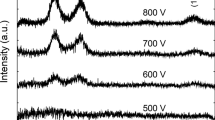Conclusions
-
1.
The polarization state of these oxides is insensitive to light in the visible region.
-
2.
The polarization state of the anodic oxide films is attenuated by UV radiation. The effect is caused by photons with energies on the order of 5 eV. These results are explained on the basis of an intrinsic absorption mechanism.
-
3.
The films studied here, especially those on Zr, which can undergo depolarization in UV light, may find applications in memory cells and in UV dosimetry.
-
4.
The metal-oxide-metal systems with a thermally depolarized oxide, subjected to UV radiation, can be used to measure the work functions of metals.
Similar content being viewed by others
Literature cited
A. I. Zudov, in: Anodic Oxidation of Metals [in Russian], KAI, Kazan (1968), p. 267.
L. A. Zudova, S. I. Agapova, A. I. Zudov, and V. A. Sterkhov, Elektrokhimiya,11, No. 8, 1239 (1975).
A. I. Zudov, L. A. Zudova, and V. A. Sterkhov, Proceedings of the All-Union Conference on the Physics of Dielectrics and the Outlook for Its Development [in Russian], Vol. 3, LPI, Leningrad (1973), p. 68.
A. I. Zudov and L. A. Zudova, Izv. Vyssh. Uchebn. Zaved., Fiz., No. 8, 15 (1967).
L. A. Zudova, S. I. Agapova, A. I. Zudov, and V. A. Sterkhov, Deposited Article No. 1173-75, All-Union Institute of Scientific and Technical Information (1975).
L. A. Zudova, A. I. Zudov, and V. A. Sterkhov, Deposited Article No. 2218-75, All-Union Institute of Scientific and Technical Information (1975).
A. L. Musatov, Fiz. Tverd. Tela9, No. 11, 3279 (1968).
R. E. Collins and A. W. Davies, Solid-State Electron.,7, No. 6, 445 (1964).
L. Young, Anodic Oxide Films, Academic Press, New York (1961).
J. H. Thomas, J. Appl. Phys.,45, No. 2, 835 (1974).
V. A. Fomichev, Fiz. Tverd. Tela8, No. 10, 2893 (1966).
M. Hartl and K. Achtziger, Phys. Status Solidi,14, No. 2, 355 (1966).
T. Yu. Musabekov and V. B. Sandomirskii, in: Questions of Film Electronics [in Russian], Sovet-skoe Radio, Moscow (1966), p. 83.
B. M. Tsarev, The Contact Potential Difference [in Russian], GITTL, Moscow (1955).
M. A. Lebedinskii, Electrovacuum Materials [in Russian], Énergiya, Moscow-Leningrad (1966).
Author information
Authors and Affiliations
Additional information
Translated from Izvestiya Vysshikh Uchebnykh Zavedenii, Fizika, No. 1, pp. 70–73, January, 1977.
Rights and permissions
About this article
Cite this article
Zudova, L.A. Photodepolarization of anodic oxide films. Soviet Physics Journal 20, 54–56 (1977). https://doi.org/10.1007/BF00891426
Received:
Issue Date:
DOI: https://doi.org/10.1007/BF00891426




